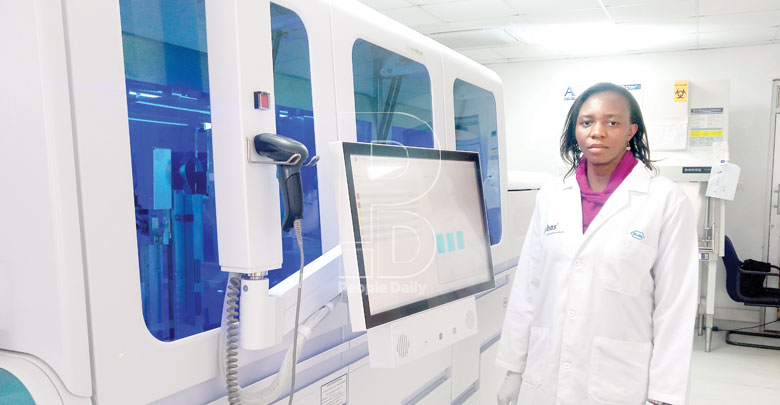Kemri trying out faster HIV viral load testing kit

Prisca Bwana inserts a tube with blood sample into a machine and waits. The assistant research officer at Kenya Medical Research Institute (Kemri) is testing the viral load of a HIV positive patient.
Using the small machine, almost the size of a desktop computer, she will know the results in less than two hours and conduct up-to eight tests on the same device in a day.
The m-PIMA HIV – ½ VL Bwana is using is a breakthrough rapid test that reveals viral load of HIV positive patients within a short time. The device gives results within 72 minutes while the patient waits, as opposed to sending the samples to a lab, which takes longer.
The newly-developed world’s first point of care viral load test is instrumental in achievement of the third 90 of the The Joint United Nations Programme on HIV and Aids (UNAids) Global 90-90-90 targets for HIV treatment.
By 2020, UNAIDS targets to have 90 per cent of people living with HIV know their status, 90 per cent of those diagnosed with HIV to be on Antiretroviral Therapy (ART) and 90 per cent of those receiving ART to have viral suppression.
The new solution, developed by health care technology company, Abbot, received the World Health Organisation’s Prequalification approval (WHO PQ) in April 2019 after the global health body carried out quality tests.
Currently, HIV patients have to wait for days and even weeks before receiving their viral load results.
Health facilities across the country rely on only 10 centralised laboratories at district, county or national level to carry out these tests. “Samples are collected from remote sites and transported to central laboratories where they are run.
Due to transport logistics and limited number of machines, results may take more than two weeks before they are delivered to the patient,” says Bwana.
Tests per month
One of the labs based at Kemri, Nairobi, for instance, receives all samples from the Nairobi, Eastern and Central regions and conducts an average of 22,000 viral load tests per month.
However, with the introduction of m-PIMA, patients will be able to get their viral load results immediately even in small health facilities across the country.
Viral load tests guide healthcare professionals on treatment choices for patients and monitors response to antiretroviral therapy.
According to UNAids, viral suppression is achieved when a patient consistently takes effective ART, and the load decreases to less than 1,000 copies per millilitre of blood.
Viral load is undetectable if it’s below 50 copies per millilitre of blood. A patient with undetectable levels has no chances of passing on the virus. Since the viral load keeps changing, one needs to take a test every six months to monitor the levels.
Globally, 81 per cent of people on ART are virally suppressed. More than half (52 per cent) of people on ART in Eastern and Southern Africa are virally suppressed.
This new technology will also make the testing more accessible. “It will promote frequent testing of viral load.
With the test being done and results being delivered on the same day, there will be more actionable outcome. At that point the patient and clinician can decide on whether to continue with the treatment or change it depending on its effectiveness,” says Dr Kuku Appiah Director, Medical and Scientific Affairs, Africa, Abbott Rapid Diagnostics.
Expected roll out
It’s even more ideal for testing HIV+ expectant mothers who need to know their viral load before delivery.
“Say a woman has few hours before delivering and she needs to quickly know her viral load so as not to pass the virus to the baby being born, m-PIMA comes in handy,” adds Appiah.
With the point of care device, technology found in big labs for testing viral load has been miniaturised into one small compact and portable machine.
Compared to COBAS 8000, one of the machines used in big labs to test viral load, m-PIMA takes a short time to release results and is more portable making it suitable for small health facilities.
COBAS 8000 machine takes up-to eight hours to release viral load results and is bulky, almost the size of a 14-seater matatu.
Unlike machines in big labs, m-PIMA device is easy to use even for people that have not received any laboratory training.
A nurse or any other healthcare professional only needs to undergo a short course on how to use the device to carry out the test unlike personnel who operate machines in big labs who need to have an understanding of molecular biology.
The m-PIMA machine has a battery backup thus it can be used in areas with no constant electricity supply and be moved from one clinic to another to cover several sites.
The device is among few HIV testing machines that can measure both HIV type 1 and 2 viruses. It is currently being tested by Kemri before rolling it out in health facilities across the country.









